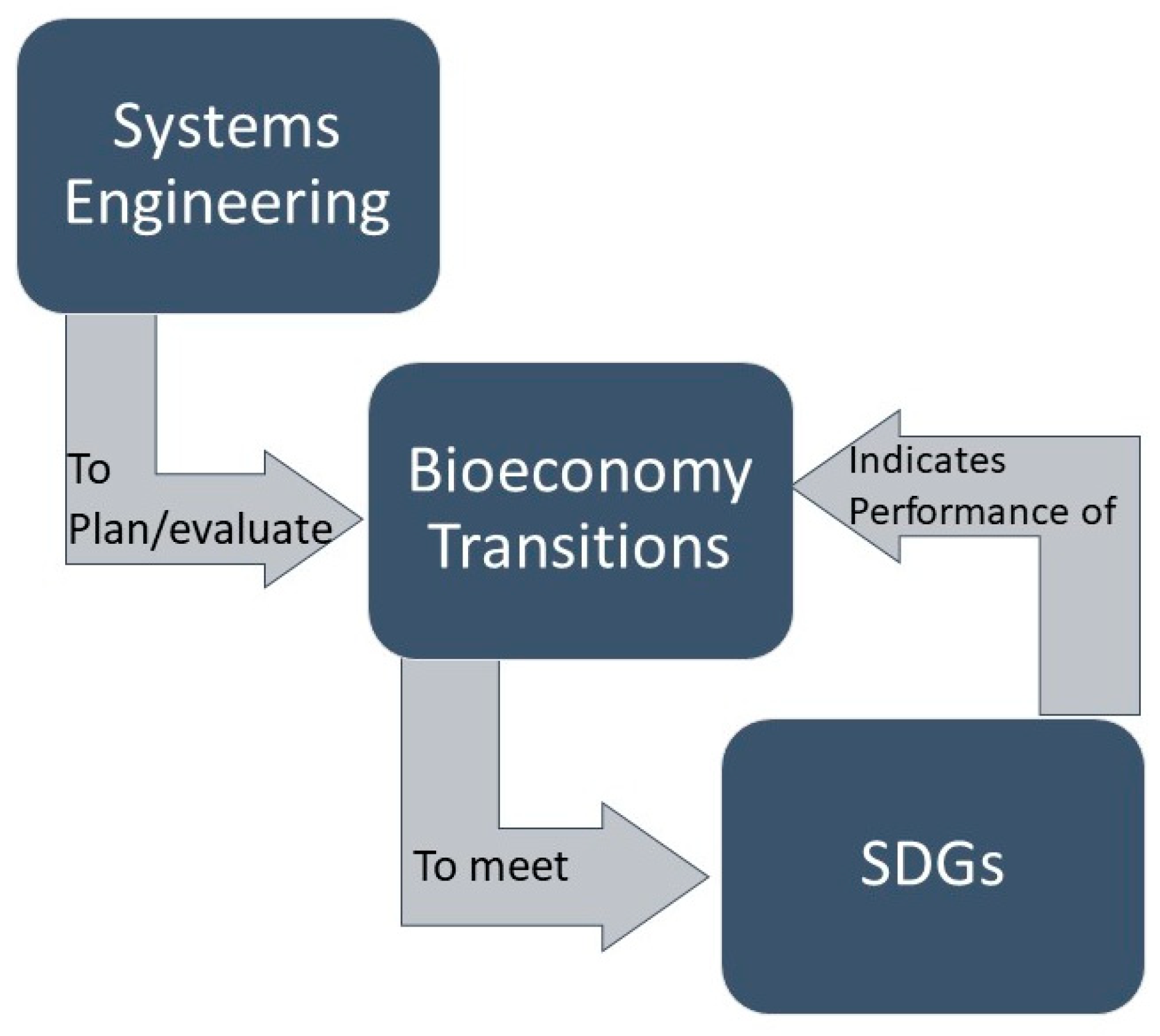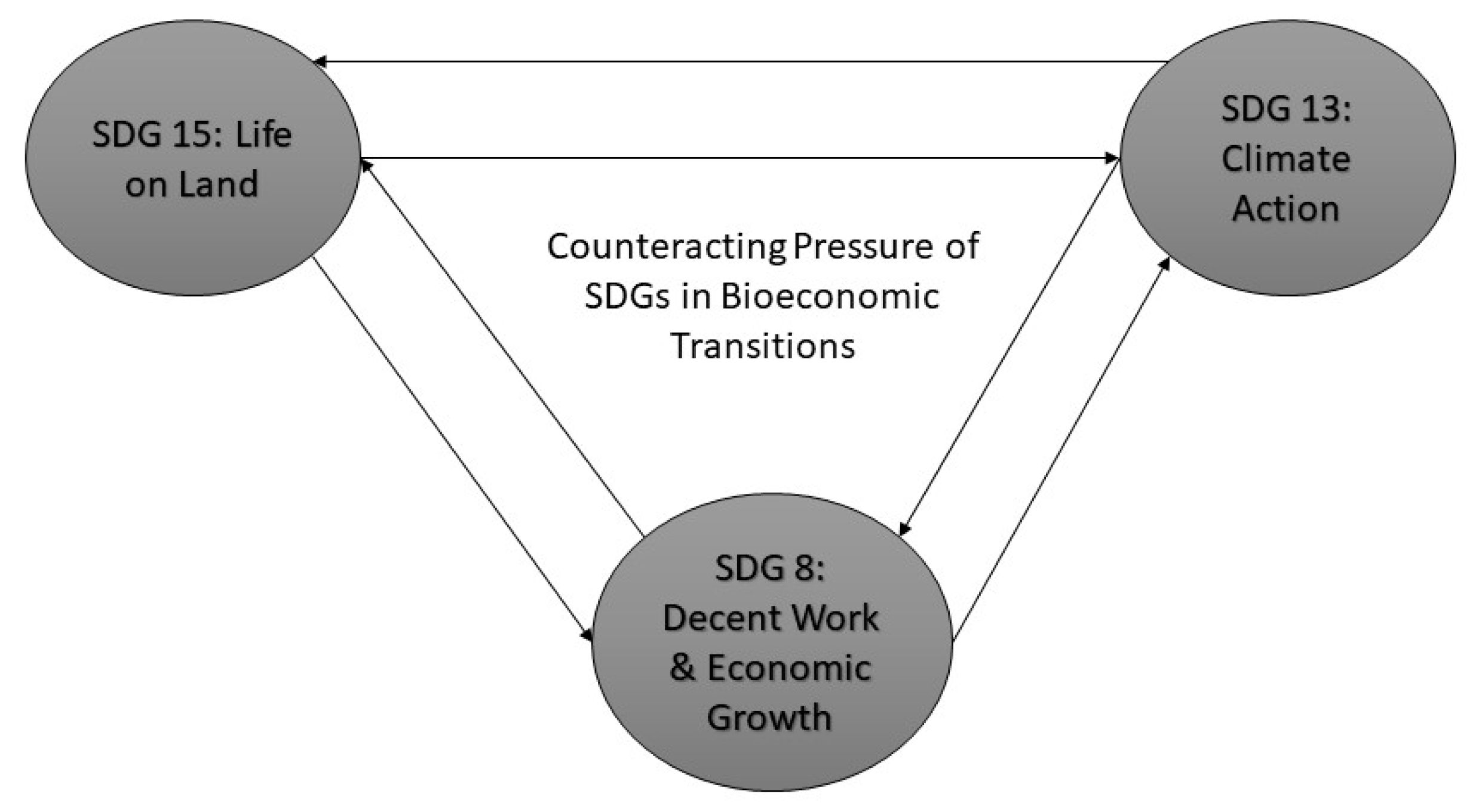A Systems Engineering Framework for Bioeconomic Transitions in a Sustainable Development Goal Context
Abstract
1. Introduction
2. Systems Mapping for Bioeconomy Transitions
2.1. Bioeconomy Transitions in Norway
2.2. MPAST: Mapping Problem Archetypes to Solutions for Transitions
2.2.1. Problem Archetypes (MPAST)–Phase 1
2.2.2. Solutions (MPAST)–Phase 2
2.2.3. Transitions (MPAST)–Phase 3
3. Case Analysis: Application of the MPAST Framework
3.1. Application: Problem Archetypes (MPAST)–Phase 1
3.2. Application: Solutions (MPAST)–Phase 2
3.3. Application: Transitions (MPAST)–Phase 3
4. Discussion: MPAST and SDGs
5. Conclusions
Author Contributions
Funding
Conflicts of Interest
References
- Zilberman, D.; Kim, E.; Kirschner, S.; Kaplan, S.; Reeves, J. Technology and the future bioeconomy. Agric. Econ. 2013, 44, 95–102. [Google Scholar] [CrossRef]
- Heimann, T. Bioeconomy and SDGs: Does the bioeconomy support the achievement of the SDGs? Earth’s Future 2019, 7, 43–57. [Google Scholar] [CrossRef]
- Ramcilovic-Suominen, S.; Pülzl, H. Sustainable development–a ‘selling point’ of the emerging EU bioeconomy policy framework? J. Clean. Prod. 2018, 172, 4170–4180. [Google Scholar] [CrossRef]
- United Nations General Assembly (UN). Transforming our World: The 2030 Agenda for Sustainable Development; United Nations: New York, NY, USA, 2015. [Google Scholar]
- Le Blanc, D. Towards integration at last? The sustainable development goals as a network of targets. Sustain. Dev. 2015, 23, 176–187. [Google Scholar] [CrossRef]
- Pradhan, P.; Costa, L.; Rybski, D.; Lucht, W.; Kropp, J.P. A systematic study of Sustainable Development Goal (SDG) interactions. Earth’s Future 2017, 5, 1169–1179. [Google Scholar] [CrossRef]
- Spangenberg, J.H. Hot air or comprehensive progress? A critical assessment of the SDGs. Sustain. Dev. 2017, 25, 311–321. [Google Scholar] [CrossRef]
- Wong, R.; Heijden, J. Avoidance of conflicts and trade-offs: A challenge for the policy integration of the United Nations Sustainable Development Goals. Sustain. Dev. 2019, 27, 1–8. [Google Scholar] [CrossRef]
- Sanz-Hernández, A.; Esteban, E.; Garrido, P. Transition to a bioeconomy: Perspectives from social sciences. J. Clean. Prod. 2019, 224, 107–119. [Google Scholar] [CrossRef]
- Parry, M.L. Climate Change and World Agriculture; Routledge: London, UK, 2019. [Google Scholar]
- Olsson, E.G.A.; Rönningen, K.; Hanssen, S.K.; Wehn, S. The interrelationship of biodiversity and rural viability: Sustainability assessment, land use scenarios and Norwegian mountains in a European context. J. Environ. Assess. Policy Manag. 2011, 13, 251–284. [Google Scholar] [CrossRef]
- Burton, R.J.F.; Fuglestad, E. Etter Oljen: Vår bioøkonomiske fremtid. Bortenfor bioøkonomien. (“Beyond the Bioeconomy”); Burton, R.J.F., Forbord, M., Ellingsted, M.B., Fuglestad, E., Eds.; Cappelen Damm: Oslo, Norway, 2020. [Google Scholar]
- Burton, R.J.F.; Kuczera, C.; Schwarz, G. Exploring farmers’ cultural resistance to voluntary agri-environmental schemes. Sociol. Rural. 2008, 48, 16–37. [Google Scholar] [CrossRef]
- Sutherland, L.-A.; Burton, R.J.F. Good Farmers, Good Neighbours? The role of cultural capital in social capital development a Scottish farming community. Sociol. Rural. 2012, 51, 238–255. [Google Scholar] [CrossRef]
- Mustalahti, I. The responsive bioeconomy: The need for inclusion of citizens and environmental capability in the forest based bioeconomy. J. Clean. Prod. 2018, 172, 3781–3790. [Google Scholar] [CrossRef]
- Skene, K.R.; Malcolm, J. Using the SDGs to nurture connectivity and promote change. Des. J. 2019, 22, 1629–1646. [Google Scholar] [CrossRef]
- Stafford-Smith, M.; Griggs, D.; Gaffney, O.; Ullah, F.; Reyers, B.; O’Connell, D. Integration: The key to implementing the Sustainable Development Goals. Sustain. Sci. 2017, 12, 911. [Google Scholar] [CrossRef] [PubMed]
- Senge, P.M. The Fifth Discipline Fieldbook: Strategies and Tools for Building a Learning Organization; Doubleday: New York, NY, USA, 1995. [Google Scholar] [CrossRef]
- Braun, W. The System Archetypes. The Systems Modeling Workbook. 2002. Available online: http://www.albany.edu/faculty/gpr/PAD724/724WebArticles/sys_archetypes.pdf (accessed on 17 August 2020).
- Wolstenholme, E. Using generic system archetypes to support thinking and modelling. Syst. Dyn. Rev. 2004, 20, 341–356. [Google Scholar] [CrossRef]
- Probst, G.; Bassi, A. Tackling Complexity: A Systemic Approach for Decision Maker; Routledge: New York, NY, USA, 2017. [Google Scholar] [CrossRef]
- Haskins, C. Using Patterns to Transition Systems Engineering from a Technological to Social Context. Syst. Eng. 2008, 11, 147–155. [Google Scholar] [CrossRef]
- Dalampira, E.-S.; Nastis, S.A. Mapping Sustainable Development Goals: A network analysis framework. Sustain. Dev. 2020, 28, 46–55. [Google Scholar] [CrossRef]
- Bauer, F. Narratives of biorefinery innovation for the bioeconomy: Conflict, consensus or confusion? Env. Inno. Soc. Trans. 2018, 28, 96–107. [Google Scholar] [CrossRef]
- Palmer, E. Systems Engineering Applied to Evaluate Social Systems: Analyzing Systemic Challenges to the Norwegian Welfare State; The University of Bergen: Bergen, Norway, 2017. [Google Scholar]
- Szajnfarber, Z.; Gralla, E. Qualitative methods for engineering systems: Why we need them and how to use them. Syst. Eng. 2017, 20, 497–511. [Google Scholar] [CrossRef]
- Bocken, N.M.; Short, S.W.; Rana, P.; Evans, S. A literature and practice review to develop sustainable business model archetypes. J. Clean. Prod. 2014, 65, 42–56. [Google Scholar] [CrossRef]
- Schellnhuber, H.J.; Lüdeke, M.K.B.; Petschel-Held, G. The syndromes approach to scaling describing global change on an intermediate functional scale. Integr. Assess. 2002, 3, 201–219. [Google Scholar] [CrossRef]
- Haskins, C. Systems Engineering Analyzed, Synthesized, and Applied to Sustainable Industrial Park Development; Norwegian University of Science and Technology: Trondheim, Norway, 2008. [Google Scholar]
- Allen, C.; Metternicht, G.; Wiedmann, T. An Iterative Framework for National Scenario Modelling for the Sustainable Development Goals (SDGs). Sustain. Dev. 2017, 25, 372–385. [Google Scholar] [CrossRef]
- Meyer, R. Bioeconomy strategies: Contexts, visions, guiding implementation principles and resulting debates. Sustainability 2017, 9, 1031. [Google Scholar] [CrossRef]
- Hansen, L.; Bjørkhaug, H. Visions and expectations for the Norwegian bioeconomy. Sustainability 2017, 9, 341. [Google Scholar] [CrossRef]
- Valseth, M.S. Innovation Norway supporting the development of an algae industry in Norway. In Proceedings of the Workshop, Nordic Algae Network and Blue Bio, Ås, Norway, 15 November 2012. [Google Scholar]
- Kleinschmit, D.; Lindstad, B.H.; Thorsen, B.J.; Toppinen, A.; Roos, A.; Baardsen, S. Shades of green: A social scientific view on bioeconomy in the forest sector. Scand. J. For. Res. 2014, 29, 402–410. [Google Scholar] [CrossRef]
- Norwegian Government. Known Resources, Limitless Possibilities; The Government’s Bioeconomy Strategy; The Ministry of Trade, Industry and Fisheries: Oslo, Norway, 2016.
- Ellingson, W. Rural Second Homes: A Narrative of De-Centralisation. Sociol. Rural. 2017, 57, 229–244. [Google Scholar] [CrossRef]
- Organisation for Economic Co-operation and Development (OECD). Bio-Economy and the Sustainability of the Agricultural and Food System: Opportunities and Policy Challenges; OECD: Joint Working Party on Agriculture and the Environment: Paris, France, 2018. [Google Scholar]
- Schellnhuber, H.J.; Block, A.; Cassel-Gintz, M.; Kropp, J.; Lammel, G.; Petschel-Held, G. Syndromes of global change. GAIA-Ecol. Perspect. Sci. Soc. 1997, 6, 18–33. [Google Scholar] [CrossRef]
- Eisenack, K. Archetypes of Adaptation to Climate Change. In Human-Nature Interactions in the Anthropocene; Routledge: New York, NY, USA, 2012. [Google Scholar] [CrossRef]
- Cavallo, M.; Gerussi, E. Bioeconomy, circular economy and industrial symbiosis: Towards a new concept of productive processes. Eco.-Ind. Parks 2015, 43–47. [Google Scholar]
- Holmberg, J.; Robèrt, K.H. Backcasting—A framework for strategic planning. International. J. Sustain. Dev. World Ecol. 2000, 7, 291–308. [Google Scholar] [CrossRef]
- Bjørkhaug, H.; Hansen, L.; Zahl-Thanem, A. Sektorvise Scenarier for Bioøkonomien. (Sectoral Scenarios for the Bioeconomy); Ruralis Rapport; RURALIS: Trondheim, Norway, 2018; p. 4. Available online: https://ruralis.no/wp-content/uploads/2018/08/r4_18-sektorvise-scenarier-for-biokonomien-h-bjrkhaug-l--hansen-og-a--zahl-thanem.pdf (accessed on 29 June 2020).
- Marchetti, M.; Vizzarri, M.; Lasserre, B.; Sallustio, L.; Tavone, A. Natural capital and bioeconomy: Challenges and opportunities for forestry. Ann. Silvic. Res. 2014, 38, 62–73. [Google Scholar]
- Burton, R.J.F. The potential impact of synthetic animal protein on livestock production: The new “war against agriculture”? J. Rural Stud. 2019, 68, 33–45. [Google Scholar] [CrossRef]
- Smetana, S.; Mathys, A.; Knoch, A.; Heinz, V. Meat alternatives: Life cycle analysis of most known meat alternatives. Int. J. Life Cycle Assess. 2015, 20, 1254–1267. [Google Scholar] [CrossRef]
- Hermans, F. The potential contribution of transition theory to the analysis of bioclusters and their role in the transition to a bioeconomy. Biofuels Bioprod. Biorefining 2018, 12, 265–276. [Google Scholar] [CrossRef]



| Syndrome Name | Syndrome Meaning |
|---|---|
| Sahel Syndrome | Overcultivation of marginal land |
| Overexploitation Syndrome | Overexploitation of natural ecosystems |
| Dust Bowl Syndrome | Non-sustainable agro-industrial use of soils and bodies of water |
| Aral Sea Syndrome | Environmental damage of natural landscapes as a result of large-scale projects |
| Green Revolution Syndrome | Environmental degradation through the introduction of inappropriate farming methods |
| Problem Archetypes-Syndromes [28] | Solutions-Sustainable Business Archetypes [27] |
|---|---|
| Sahel Overexploitation Dust Bowl Aral Sea Green Revolution | Adopt a Stewardship Role |
| Repurpose for Society and the Environment |
| SPADE Analysis | ||||
|---|---|---|---|---|
| Stakeholders | Problem | Analysis | Decision/Tradeoffs | Evaluation |
| Farmers Agri-Business Local/Rural Communities Consumers Cooperative Agricultural Supplier Academia/Research Politician Environment | Energy Sources Waste Soil depletion Markets | Resource Stewardship | Income and Financing Heritage/Cultural Identity | Iterative evaluation of the S,P,A,D parts of SPADE framework |
| MPAST | Phase 1: Problem Archetype | Phase 3: Transition to | Phase 2: Solution Archetype |
|---|---|---|---|
| Archetypes Set/Framework | Syndromes | SPADE | Sustainable Business Model Archetypes |
| Analysis | Overexploitation | Resource Stewardship Iterative Pathway | Adopt a Stewardship Role |
© 2020 by the authors. Licensee MDPI, Basel, Switzerland. This article is an open access article distributed under the terms and conditions of the Creative Commons Attribution (CC BY) license (http://creativecommons.org/licenses/by/4.0/).
Share and Cite
Palmer, E.; Burton, R.; Haskins, C. A Systems Engineering Framework for Bioeconomic Transitions in a Sustainable Development Goal Context. Sustainability 2020, 12, 6650. https://doi.org/10.3390/su12166650
Palmer E, Burton R, Haskins C. A Systems Engineering Framework for Bioeconomic Transitions in a Sustainable Development Goal Context. Sustainability. 2020; 12(16):6650. https://doi.org/10.3390/su12166650
Chicago/Turabian StylePalmer, Erika, Robert Burton, and Cecilia Haskins. 2020. "A Systems Engineering Framework for Bioeconomic Transitions in a Sustainable Development Goal Context" Sustainability 12, no. 16: 6650. https://doi.org/10.3390/su12166650
APA StylePalmer, E., Burton, R., & Haskins, C. (2020). A Systems Engineering Framework for Bioeconomic Transitions in a Sustainable Development Goal Context. Sustainability, 12(16), 6650. https://doi.org/10.3390/su12166650





